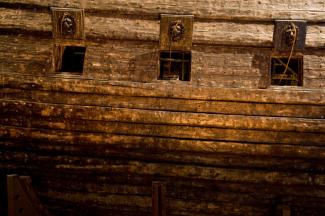
Let’s go back to Stockholm in the year 1628. On the 10th of August a huge Swedish warship called VASA leaves the harbour of Stockholm on its first (maiden) voyage. On board are not only sailors and soldiers, but also their families who are allowed to travel with the crew for a while. The king ordered the building of battle ships, including the Vasa, in hope of transforming Sweden into one of the greatest naval powers of Europe. Not only the size was impressive (height: 52,5 metres from the keel to the top of the mainmast, length: 69 metres, breadth: 11,7 metres) but also for the first time 64 cannons were fixed onto two decks of the ship.
25 minutes after the launch of the Vasa, thousands of watching people from Stockholm are in shock: a gust of wind takes the massive sails and the huge vessel leans dangerously to one side! Horror strikes when it becomes clear that the gun ports on one side (still open for the salute) fill with water immediately. Within a short amount of time, the Vasa has sunk to the bottom of the sea and has taken 30 of 150 people with her – only 1,3 kilometres away from the city! Rumours about the sinking emerge in Sweden and the rest of Europe – whose fault was it that two years of hard work, loads of money and the lives of 30 people are lost? As it turns out, the captain of the Vasa knew that the ship was not stable for a journey because it was built too narrow and the central point of gravity was too high. This is why a gust of wind was enough to sink it! However, the admiral, who was afraid of telling the king that all these years of work had been for nothing, took the risk - and lost.
Stockholm today.
Not far from the city centre, on an island that belongs to the king of Sweden, I see two masts rising from the top of a high building – the very popular Vasamuseet (Vasa museum). Entering the hall of the museum I am amazed by the view: the Vasa ship emerges in full size in front of me. After a free tour I’ve learned that 95 per cent (!) of the ship is original: in the 1960s the wreck was found on the bottom of the sea and raised up to the surface without breaking it. The preservation of the Vasa took another three decades until Stockholm opened up a museum around the ship in 1990. People could now explore the fascinating mystery of the warship.
Calling the Vasa a complete failure does not seem fair: because of the sinking, science was able to make progress, especially on preservation techniques. The archaeological findings from the ship (including human skeletons and their belongings) tell us a lot about how people used to live in the 17th century. Moreover, the Vasa, a great loss for the country back then, now creates an income for many people working in the tourist sector.
The Swedish King Gustav II Adolf made this ship hoping to be remembered. Never in his wildest dreams could he have imagined what the future would hold for his "unlucky" flagship.
For more information see: http://www.vasamuseet.se/en/
Are there any important moments in the history of your country that interest you?
